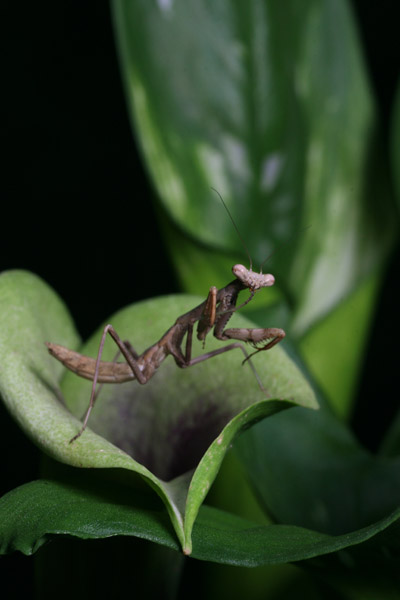 Gosh, it’s been, what, six whole hours since I’ve posted anything about the resident mantids? I cannot apologize enough – I know how you must feel.
Gosh, it’s been, what, six whole hours since I’ve posted anything about the resident mantids? I cannot apologize enough – I know how you must feel.
Okay, it’s been a bit longer than that, and in fact, this first image was taken nine days ago and not posted then. [See what I did there? I prefaced with hyperbole and followed with a contrasting statement, and now another post about mantises suddenly doesn’t seem so bad. You cannot spell manipulative without Al – well, sorta.]
On the same lily blossom that we’ve seen before, though showing even more of its age now, a Carolina mantis (Stagmomantis carolina) also performed a modeling session, completely unprompted – there seems to be something about the plants on the deck, and the lily in particular. I’d be inclined to say that it’s because the flower attracts pollinators and thus food for the mantids, except that I have never seen a pollinator even near them, and now they’re well past attracting such anyway.
The Carolina mantis species is smaller than the Chinese mantis, differently colored, and for reasons unknown, seem to be considerably less common, at least in both areas that I’ve been shooting in routinely. I have no preference for either, really, though getting the detail shots of the larger species is always easier. Carolina mantises seem to have an ‘urban camouflage’ color scheme, and by extension may prefer plants on which they blend in better, which we may not have in the immediate vicinity. Or they may normally be so good at camouflage that I simply do not see the dozens that abound, which would be a blow to my observational ego to be sure.
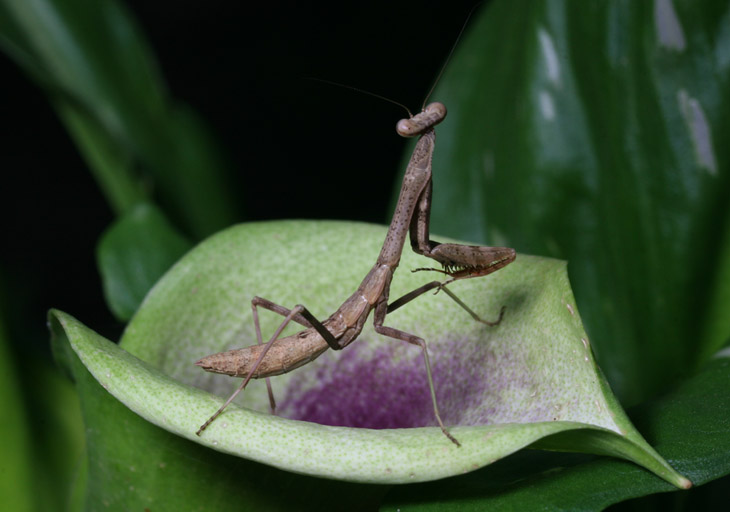
The difference in sizes is now readily apparent among the various mantids in the area, showing that some are more adept at finding food than others (you can compare sizes against the images in the previously linked post, or linked again right here.) Two that I thought had moved on suddenly reappeared last night when I misted the Japanese maple, making me suspect they’d simply been hiding from the heat – it’s been a while since the last rain now. But one in particular has moved ahead of the others.
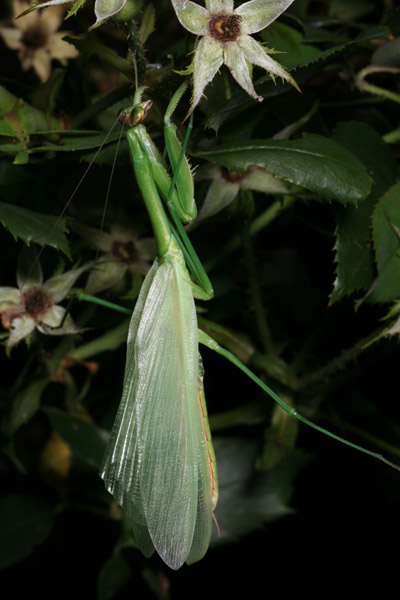 The Chinese mantis (Tenodera aridifolia sinensis) on the rose bush was found during a watering session around midnight the other night, displaying the newly extended wings from a recent molt. They’re still not dry in this photo, which is why they appear a little unkempt; they’re also paler than they will be when dry, which we’ll get to shortly. The wings don’t become this big, or functional, until the final instar, the reproducing adult phase, so now the quest is on to find a mate.
The Chinese mantis (Tenodera aridifolia sinensis) on the rose bush was found during a watering session around midnight the other night, displaying the newly extended wings from a recent molt. They’re still not dry in this photo, which is why they appear a little unkempt; they’re also paler than they will be when dry, which we’ll get to shortly. The wings don’t become this big, or functional, until the final instar, the reproducing adult phase, so now the quest is on to find a mate.
Also notable, to me anyway, is that even this late at night, it is not displaying the dark eyes that are typical of mantids after sunset, leading me to believe that the act of molting affects this in some way. It is not particularly surprising, in that they will not be actively hunting for a period of time before and after the molt, because it takes up so much of their effort and their chitin has to dry and harden afterward, but it implies that the change in eye color is not as automatic as I suspected. Plus, I guess the additional camouflage cannot hurt.
The old exoskeleton was not immediately obvious – it usually can be found attached to a branch very close to the newly-emerged adult – but a quick search on the ground revealed it in the grass.
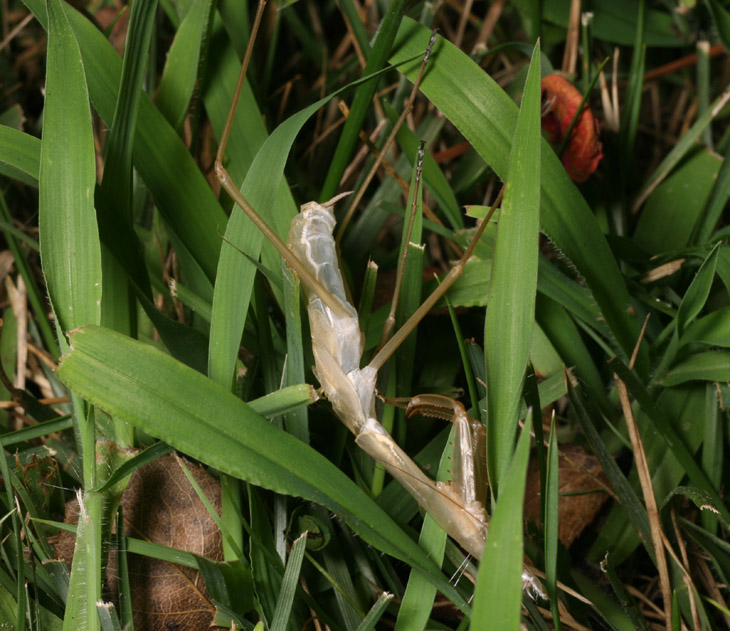
The head is towards the bottom in this shot and hiding behind a blade of grass, thought the antenna is easily spotted, but what I want to draw attention to is the wings – that’s them along the body by the legs, slightly darker than the skin of the abdomen to which the legs are attached. Yes, those wings above came out of these little sleeves – it always amazes me. In fact, the entire insect always seems to emerge much bigger than it was before the molt, and I’ve seen this often enough that I don’t think I’m imagining it, or mistaking the drying, shrinking exoskeleton that it just discarded as falsely representing the original size. One of these days I’ll have distinct measurements for before and after (and maybe even capture the process from beginning to end) to establish this once and for all. But it’s pretty obvious that the wings themselves undergo just a wee bit of expansion.
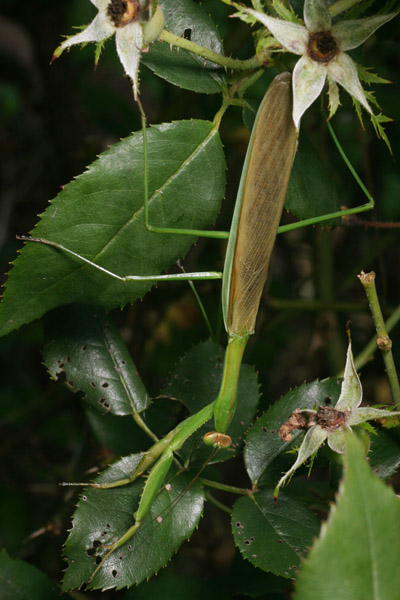 Ten hours later, the wings were dry and displaying the adult coloration, as well as presumably being functional – I am guessing this is a female who will be waiting for an acceptable male to find her, especially since she seems to like the rose bush. I am not going to discourage this in any way, since it would be easy to find an egg sac should she place it there, and may well give me the opportunity to photograph her producing it. Measured just now for this post, the mantis is about 86mm in length (3.5 inches) from the head to the wingtips, quite a change from the 10mm that they typically are when hatched. She won’t get a whole lot bigger than this, though she (if I have the sex right) will get considerably broader until producing the eggs. Keep checking back with me, and we’ll see what happens.
Ten hours later, the wings were dry and displaying the adult coloration, as well as presumably being functional – I am guessing this is a female who will be waiting for an acceptable male to find her, especially since she seems to like the rose bush. I am not going to discourage this in any way, since it would be easy to find an egg sac should she place it there, and may well give me the opportunity to photograph her producing it. Measured just now for this post, the mantis is about 86mm in length (3.5 inches) from the head to the wingtips, quite a change from the 10mm that they typically are when hatched. She won’t get a whole lot bigger than this, though she (if I have the sex right) will get considerably broader until producing the eggs. Keep checking back with me, and we’ll see what happens.
I just have to mention this, though it has nothing to do with the topic. This past weekend, our friends stopped by for a brief visit on their way to the beach, and the adolescent girls got to see this particular mantis. I had to inform them that it molted out just a couple of days after they’d left, depriving them of the opportunity to see it. In response, I get back word that they had gotten to see baby sea turtles emerging from the nest and paddling into the ocean. The single blurry photo they’d forwarded, taken at dusk with a telephoto lens past the crowd, was enough to send The Girlfriend into an uncontrollable bout of baby talk, so I can’t imagine what seeing the real thing would have done. But yeah, that whole ‘cute’ thing again…
















































